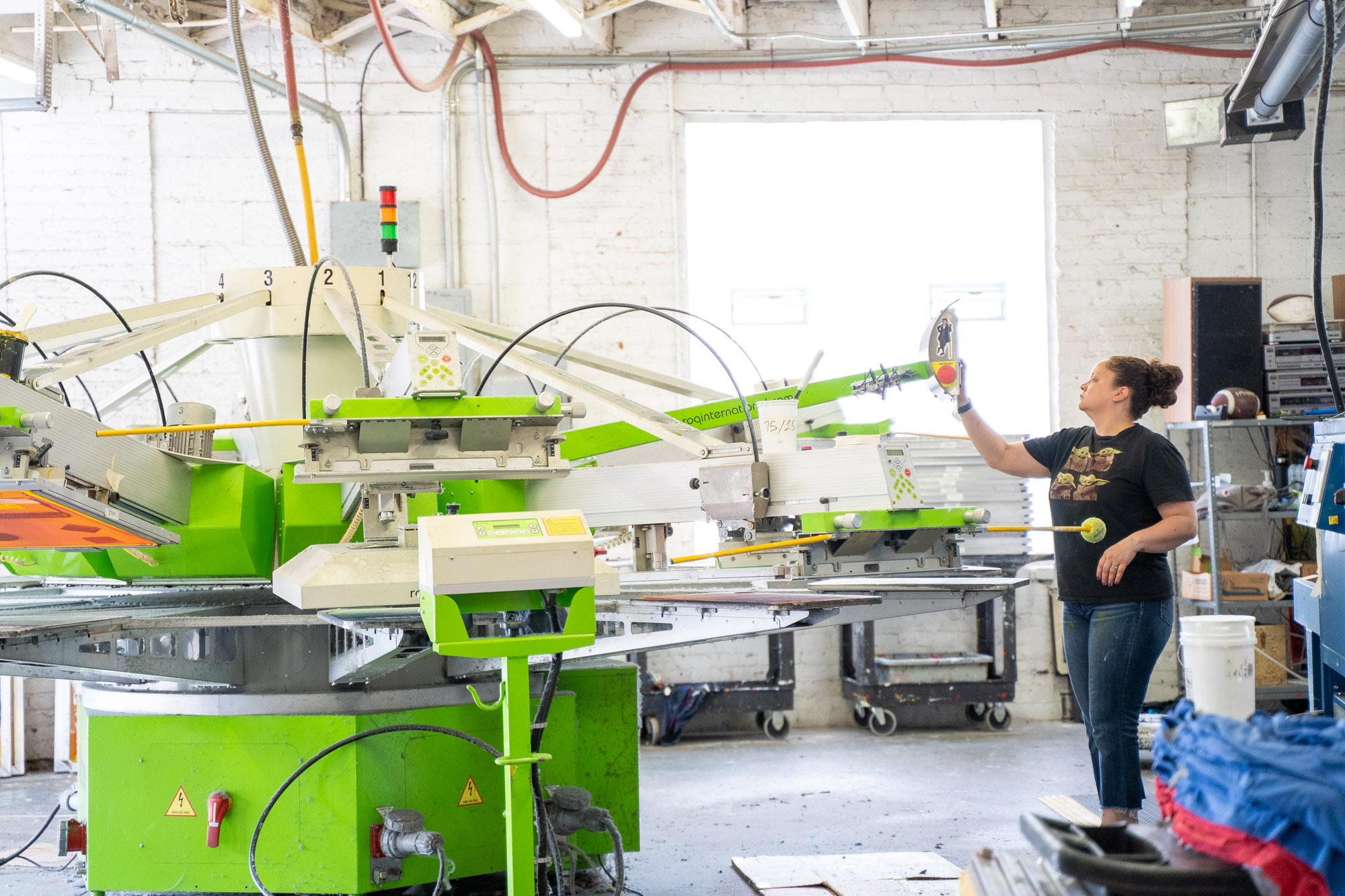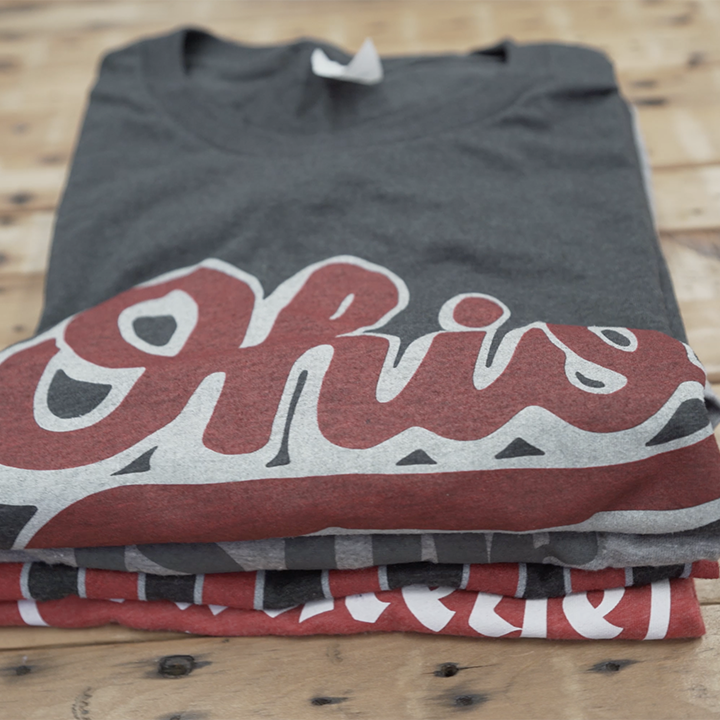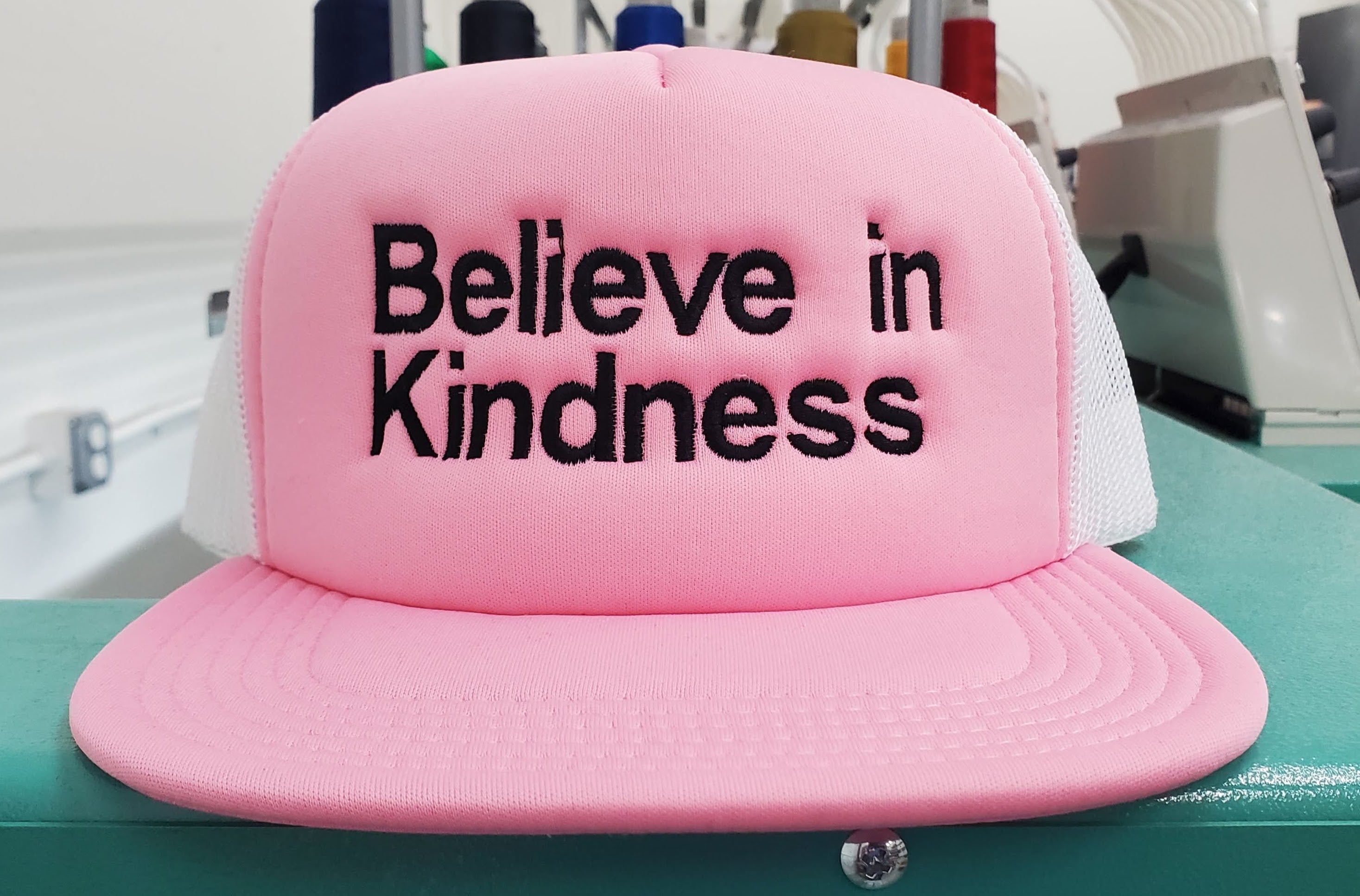New Technology for Making Screens
We are updating this post because in 2021 we brought in a new piece of equipment to make our screens and shirts even better.
When this post was originally written, we used film and an exposure unit to burn our screens. Our new equipment eliminates the need for both of those items.
Our new equipment is called a CTS which is short for Computer To Screen. It allows us to write each design directly onto a coated screen.
The video above gives a quick breakdown on how the CTS changes the way that we image and burn screens for the clothing that we print.
You'll want to keep reading below because we go more in to depth on the process and because film and an exposure unit is the more common method for screen making.
There are two major changes to the process now that we have a CTS.
The first is that the image we are burning onto a screen is written on the screen with wax. A rip system to send the files to the computer, we pull them up on the computer, click print, and it does the rest.
Imaging the screen directly saves us a lot of time and the wax produces better detail than the film we used previously. The black wax does not need time to dry and can be exposed immediately after the image is complete.
The second change is that because the image is written directly on the screen, we no longer require an exposure unit with glass. The presence of glass in an exposure unit is the number one cause of pinholes in a screen. It's incredible that we don't have to worry about this anymore.
We are using an LED light to expose screens. We show how this works in the video above. The LED light allows us to exposure two screens at once and cuts our exposure time to 30 seconds per exposure.
We hope this update is informative and shows you just how many different ways people can burn screens for screen printing shirts. Keep reading below for a more in depth description of the entire process.
Learning How To Burn A Screen
For me, learning how to successfully burn a screen was the single hardest part about learning how to screen print.
I first started to teach myself how to screen print at the end of 2011. While I consider myself self taught, I had spent some time in other screen print shops and had pulled a squeegee once or twice before. However, I had never gone through the full process on my own.
There’s a lot more to screen printing than moving a squeegee. You have to get the screens on press, register multiple screens, flash and cure the ink, and coat and burn a screen, among other things.
My original screen printing equipment was purchased off Craigslist. It was a hobbyist set up that included some spare ink and emulsion, a small tabletop exposure unit, screens, and a single color press with a flash unit.
I spent days trying to burn a screen correctly. I tested different exposure times, coating techniques, and transparency. They all failed.
And I was staring down the barrel of a failing business.
What I didn’t know at the time was there was a simple fix. The emulsion I was using had gone bad. When I replaced the emulsion I was able to troubleshoot and burn a usable screen.
Learning to burn good, consistent screens is important. It's called screen printing for a reason. You can't get off the ground without first burning a screen. Better screens lead to better prints.
My goal with this post is to show you and explain to you how we burn screens now and provide some tips on how to get started burning screens on your own.

What to prepare before burning a screen
There are a few things you’ll need to prepare before burning a screen. These tasks can be performed simultaneously.
The first thing you need to do is coat your screen with emulsion. Your emulsion will come with instructions on how to properly use it.
There are two types of emulsion. I’m not going to get into the specifics (here’s a good article if you want to know more), but the basics are that you have a one part and a two part emulsion. The one part, or presensitized, emulsion is ready to go out of the bucket. The two part emulsion, or diazo, needs to be mixed before use.
While there are differences between the two, either emulsion can work for you. My best advice is to find a reliable brand (SAATI, Ulano, Chromablue, etc.), choose one, and go for it. And as I mentioned earlier, fresh emulsion is important. Make sure you start with a new batch and keep the lid shut tight.
When you’re just getting started, the trickiest part about coating a screen is getting an even coat of emulsion on the screen. The most common tool for coating screens is a scoop coater. It’s standard in most shops.
This is difficult to do without a scoop coater. In the absence of a scoop coater, you’re going to have to get clever and be prepared to struggle. Your next best bet for coating is going to be a squeegee.
If the emulsion isn’t coated evenly on a screen it will be a mighty challenge to burn your image. This is because the varying thickness of emulsion will require different times to fully expose. So the areas of thicker emulsion on your screen may be underexposed while the thinner areas will be fine.
Emulsion is light sensitive. It’s best to coat a screen in a dark room. However, if you don’t have one, move quickly and don’t leave your emulsion or coated screen in the light for long.
For the first few years I was screen printing, I coated screens under normal fluorescent light and near a double door that we often kept open. When it was time to coat I would close the doors, turn off the lights directly above me, and get to work. If I coated too many screens, the emulsion would start to harden in the scoop coater.
In the beginning, you’ve got to do what’s necessary to get the job done. Our screens are much better now but we’ve had time to add better equipment, screens, film, and space. The little amount of light the emulsion and screens were exposed to in those early days had a minor effect on the overall quality of the final screens. They were still good enough to get the job done.

How to burn a screen for screen printing
We use an epson P5000 with Accurip that uses roll film to print our art.
When I first started I used vellum. If you’re learning to do this, the most important thing is that you want to make sure your ink is as black as possible when printed.
We use two size screens - one for our manual press and larger screens for our auto. The auto screens have a registration system to align the film. For the manual, we just use a tape measure.
If you don’t have a dark room like us, that’s fine. Just get a cart, throw black out curtains over it, and move quickly when you’re under normal light.
We’ve had three different exposure units since I started screen printing. I bought all of them used. If you watch the video above, you can see when our exposure starts that it needs to achieve vacuum before the light kicks on. Once it does that, the screen burns for about a minute.
If you don’t have an exposure unit with vacuum, you can put some weight on top of it to keep the film flat on the screen. Or, if you are exposing with a light on top of the screen, place a piece of plexi or glass on top of the film to keep it flat.
Our emulsion is the reddish coating that you see on the screen. In our exposure unit, there is a light that shines up at the screen and hardens all of the emulsion that is exposed to light. The area covered by the black artwork will not harden and we can wash it out.
After the screen is exposed, we drop it in a dip tank filled with water. This makes it easier to rinse out. We then spray the image out with a pressure washer, but a hose works fine, too.

After spraying the screen out, we take a second look at the art to check for pinholes and then set it on the rack to dry. If you do have pinholes, you can tape over them or touch them up with your emulsion.
Once the design is rinsed out of the screen, it’s time to let it dry. After it dries, you’re ready to print shirts!
Some final tips and tricks to burn a quality screen for making t-shirts
One of the hardest things about burning a screen is figuring out your exposure time. The best way to do this is with a step calculator. It’s a little plastic film strip with numbers and varying degrees of transparency. You place it under the screen while you’re burning it and when you spray it out it will tell you if you are over or under exposed.
Figuring out your exposure time takes a lot of patience and practice to get it right. Make sure you’re using good, fresh emulsion. Remember, I made this mistake when I first started.
If the emulsion is old it may not expose correctly. A trick to extend the life of your emulsion is to keep it in your fridge after you open it. If you get used emulsion from someone, don’t expect it to work.
I would recommend starting with a longer exposure time and then dialing it down. It’s better to have an overexposed screen in the beginning than an underexposed screen. And it’s more common to see underexposed screens than over. So chances are you need to extend your exposure time.

The film you use for your art is important. When I first started out, I bought transparencies from FedEx. Oftentimes the ink wasn’t black enough and I wouldn’t get a crisp image on the screen. If you go this route, request that they only use black ink to print the transparency. If the ink is still giving you trouble, make two of them and double them up.
Don’t be afraid to ask for help. Reach out to screen printers in your area, join one of the many screen printing groups on Facebook, and watch videos on YouTube.
At the end of the day, learning how to burn a screen is difficult.
Your challenges and frustrations are not unique. The great part about screen printing is that you can try and try again. Learn from your mistakes and keep trying and you’ll be better in a week than you are now.
You’ll be glad you did when you get to wear that first shirt you printed successfully.
You can check out some of our other behind the scenes how to blogs and videos at the links below:
How we screen print rainbows on t-shirts
Top 4 ways we screen print a vintage t-shirt
How we embroider our Ohioan sweatshirts
How we embroider custom hats on our 6 head embroidery machine








Comments
Fred, I’m not familiar with the x press screen maker. I would keep an eye on Craiglists and Facebook Marketplace for used equipment.
i want to generate l5" x 15" tranfers so i can promote or advertise a message on a t shirt or cap. i use to use an x press l000 screen maker. non chemical, but cant find a used one have lots of orders but small capitol to work with.
Write a comment